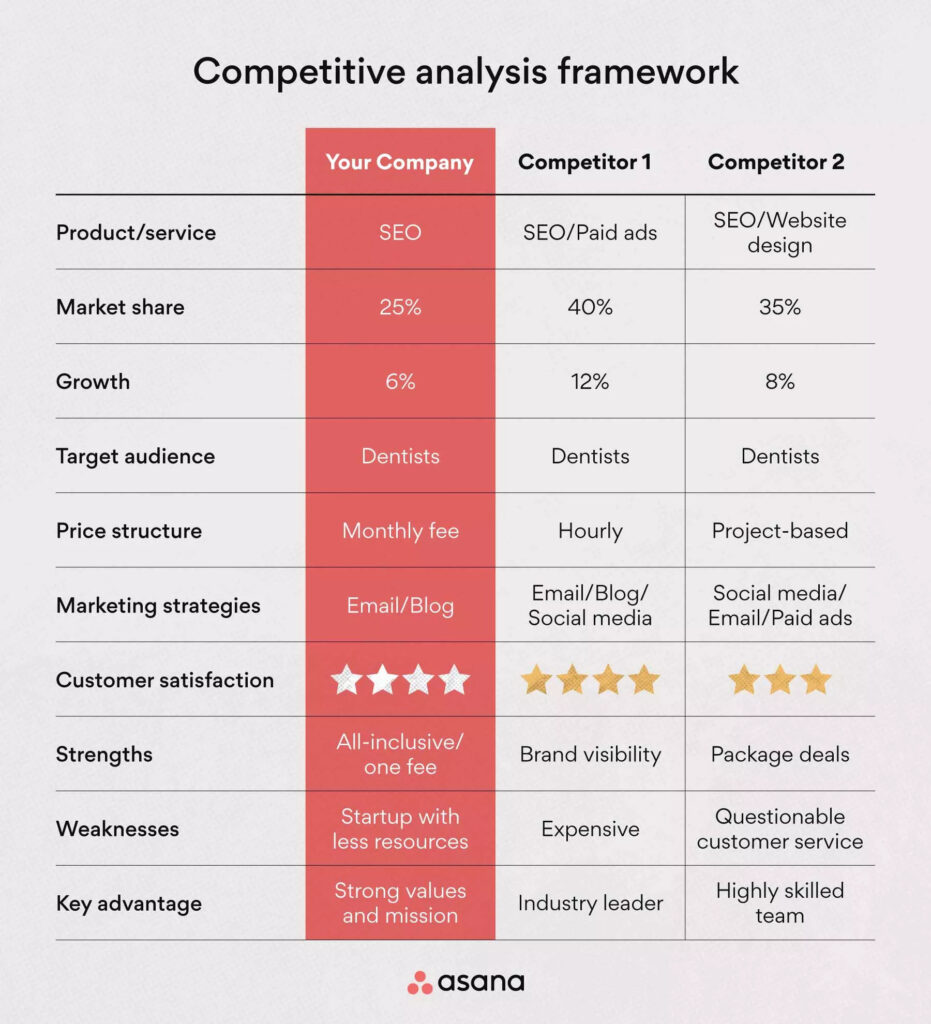In today’s fast-paced business world, understanding your competition is not just beneficial—it’s essential.
Whether you’re launching a new product, entering a new market, or simply looking to stay ahead, a competitor analysis can provide invaluable insights.
Here’s a step-by-step guide to help you navigate this process.
How to Conduct a Competitor Analysis: A Detailed Guide
1. Recognize the Importance
Understanding “How to Conduct a Competitor Analysis” is the first step towards gaining a competitive edge.
It’s not merely about gathering data; it’s about interpreting this data to carve out a unique space for your business in the market.
By comprehensively analyzing your competitors, you can anticipate market shifts, identify emerging trends, and craft strategies that resonate deeply with your target audience.
2. Identify Your Competitors
When considering how to conduct a competitor analysis, start by pinpointing who your competitors really are.
Direct competitors are businesses that offer the same products or services to the same audience.
Indirect competitors, on the other hand, might target a different audience or offer slightly varied products.
By categorizing competitors, you can tailor your strategies to address specific threats and opportunities.
Related article: How to Identify Your Competitors in 6 Steps
3. Dive Deep with Research
Research is the backbone of any competitor analysis.
- Primary Research: This involves direct interactions. You could purchase competitors’ products to understand their user experience or conduct surveys to gauge customer preferences.
- Secondary Research: Here, you’re relying on existing data. Explore competitors’ websites, and customer reviews, and use tools like SEMrush to gain insights into their online presence. Remember, understanding how to conduct a competitor analysis means being thorough in your research approach.
Related article: SEO Keyword Research Guide
4. Analyze Product Offerings
In the journey of understanding how to conduct a competitor analysis, assessing product offerings is crucial.
Examine the features, pricing, quality, and after-sales service of your competitors.
It’s essential to understand not just what they offer, but also why customers might prefer their products over others.
This will give you insights into potential gaps in your own offerings.
5. Understand Their Marketing Strategies
Marketing is a significant battleground in today’s digital age.
When figuring out how to conduct a competitor analysis, delve into your competitors’ marketing tactics:
- Examine their social media activity, the kind of content they post, and the engagement they receive.
- Look into their advertising campaigns, both online and offline.
- Understand their brand voice, messaging, and the promises they make to their customers.
For upgrading your understanding in this section, do check out this blog Best Marketing Strategies to Follow in 2023
6. Conduct a SWOT Analysis
A SWOT analysis is a comprehensive tool that breaks down your findings into strengths, weaknesses, opportunities, and threats.
When considering how to conduct a competitor analysis, this step is invaluable.
It not only helps you understand your competitors but also provides a clear picture of where you stand in comparison.
By identifying areas of opportunity and potential threats, you can craft strategies that are both proactive and reactive.
Related article: How to Do a SWOT Analysis (With Examples & Free Template!)
7. Position Yourself in the Market
With the insights gathered, it’s time to understand your market position.
Are you a leader, or are you chasing the leader? Maybe you’re carving out a niche space?
Knowing your position helps in crafting strategies that play to your strengths and address your weaknesses.
Remember, understanding how to conduct a competitor analysis is as much about understanding yourself as it is about understanding your competitors.
Move forward hearing out this exclusive interview with Seth Godin explaining his approach towards Market Positioning.
8. Take Action
The insights from your competitor analysis are only as good as the actions they inspire.
Use the data to refine your product offerings, enhance your marketing strategies, and communicate more effectively with your audience.
Knowing how to conduct a competitor analysis is vital, but acting on that knowledge is what truly drives success.
9. Keep the Analysis Updated
The business world is dynamic.
Competitors evolve, market trends shift, and customer preferences change.
Regularly updating your competitor analysis ensures that you’re not basing decisions on outdated information.
Make it a habit, and you’ll always be prepared to adapt and thrive.
Conclusion
Conducting a competitor analysis might seem daunting, but with the right approach, it can be incredibly enlightening.
Here is an example of a competitive analysis framework by asana. Have a look-

Remember, it’s not about copying what others are doing; it’s about understanding the market better so you can serve your customers in the best possible way.
So, dive in, gather those insights, and let them guide you to success.




